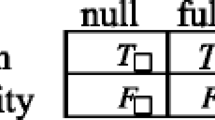Abstract
Consider a set S of statements that may be taken to represent an idealized body of scientific knowledge. Let s 1 and s 2 be members of S. Should we regard the conjunction of s 1 and s 2, also as a member of S? It is tempting to answer in the affirmative, and a number of writers, whose systems we shall consider below, have indeed answered this way.
Much of the research on which this paper is based has been supported by the National Science Foundation, through grants 708, 1179, and 1962.
Access this chapter
Tax calculation will be finalised at checkout
Purchases are for personal use only
Preview
Unable to display preview. Download preview PDF.
Similar content being viewed by others
Bibliography
R. B. Braithwaite, Scientific Explanation, Cambridge 1953.
Gilbert Harman, ‘Detachment, Probability and Maximum Likelihood’, Nous 1 (1967) 401–11.
Carl Hempel, ‘Deductive-Nomological vs. Statistical Explanation’, in Minnesota Studies in the Philosophy of Science, III (ed. by H. Feigl and G. Maxwell ), Minneapolis 1962.
Jaakko Hintikka, ‘Towards a Theory of Inductive Generalization’, in Proc. 1964 International Congress for Logic, Methodology, and Philosophy of Science (ed. by J. Bar-Hillel ), Amsterdam 1965.
Jaakko Hintikka, ‘Distributive Normal Forms in First-Order Logic’, in Formal Systems and Recursive Functions (ed. by Crossley and Dummett), Amsterdam 1965.
Jaakko Hintikka, ‘A Two-Dimensional Continuum of Inductive Methods’, in Aspects of Inductive Logic (ed. by J. Hintikka and P. Suppes ), Amsterdam 1966.
Jaakko Hintikka and Risto Hilpinen, ‘Knowledge, Acceptance, and Inductive Logic’, in Aspects of Inductive Logic (ed. by J. Hintikka and P. Suppes ), Amsterdam 1966.
Richard Jeffrey, The Logic of Decision, New York 1965.
Henry E. Kyburg, Jr., Probability and the Logic of Rational Belief, Middletown 1961.
Henry E. Kyburg Jr., ‘Probability and Randomness’, Theoria, 29 (1963).
Henry E. Kyburg Jr., ‘Probability, Rationality, and Rule of Detachment’, in Proc. 1964 Congress for Logic, Methodology and Philosophy of Science (ed. by J. Bar-Hillel ), Amsterdam 1965.
Keith Lerher, ‘Induction, Reason, and Consistency’, forthcoming in Minnesota Studies in the Philosophy of Science.
Isaac Levi, Gambling With Truth, New York 1967.
Wesley Salmon, private correspondence.
Raimo Tuomela, ‘Inductive Generalization in an Ordered Universe’, in Aspects of Inductive Logic (ed. by J. Hintikka and P. Suppes ), Amsterdam 1966.
References
Except in one of Keith Lehrer’s systems, described in this volume.
A muddier version of this argument was presented in [11]; a cleaned-up version is mentioned by Harman in [2].
These principles are not essential parts of the Bayesian or Classical statistical theory. One can develop the theory of statistical inference without considering the question of acceptance one way or the other. The classical theory requires us to reject certain hypotheses, but it is hardly necessary to point out (as statisticians of this persuasion inevitably do) that to reject a statement is not (necessarily) to accept it. Bayesian theory is sometimes coupled with a philosophy according to which one never accepts any hypothesis.
The test interval for ‘p ∈ (a, f)’ will include the closed interval [a, f] and the test interval for ‘p ∈ (f, b)’ will include the closed interval [f, b].
Author information
Authors and Affiliations
Editor information
Editors and Affiliations
Rights and permissions
Copyright information
© 1970 D. Reidel Publishing Company, Dordrecht, Holland
About this chapter
Cite this chapter
Kyburg, H.E. (1970). Conjunctivitis. In: Swain, M. (eds) Induction, Acceptance and Rational Belief. Synthese Library, vol 26. Springer, Dordrecht. https://doi.org/10.1007/978-94-010-3390-9_4
Download citation
DOI: https://doi.org/10.1007/978-94-010-3390-9_4
Publisher Name: Springer, Dordrecht
Print ISBN: 978-94-010-3392-3
Online ISBN: 978-94-010-3390-9
eBook Packages: Springer Book Archive




